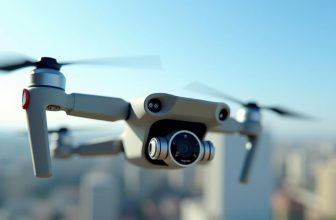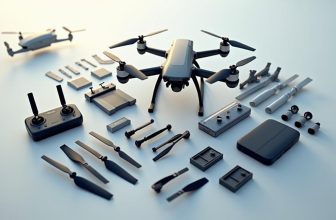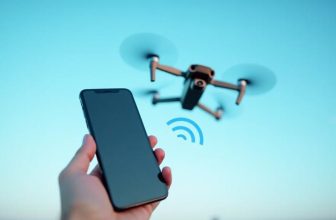
You might be surprised to learn that some racing drones can reach speeds of over 80 miles per hour. While that's an impressive statistic, it raises a lot of questions about what makes these drones so fast. From the design of the drone itself to the power of its motors, there are many factors that contribute to a drone's top speed. As you explore the world of racing drones, you'll likely want to know more about how these speeds are achieved and what it takes to build a drone that can keep up with the competition.
Contents
- 1 Key Takeaways
- 2 Top Speeds of Racing Drones
- 3 Factors Affecting Drone Speed
- 4 Drone Design and Speed
- 5 Motor Power and Efficiency
- 6 Lightweight Materials Used
- 7 Racing Drone Speed Records
- 8 Safety Features and Speed
- 9 Drone Speed Vs Human Reaction
- 10 Future of Drone Racing Speed
- 11 Frequently Asked Questions
- 12 Conclusion
Key Takeaways
- Top speeds of racing drones range from 25-40 mph for Tiny Whoop drones to over 80 mph for 5-inch Quad drones.
- Factors like air resistance, wind, temperature, humidity, and air pressure affect drone speed and performance.
- Aerodynamic frame design and efficient propulsion systems are crucial for achieving top speeds in racing drones.
- Advanced materials like carbon fiber and innovative motor designs also contribute to increased speed and efficiency.
- The current Guinness World Record for the fastest drone is over 180 miles per hour, with records consistently being broken.
Top Speeds of Racing Drones
When it comes to racing drones, top speed is a critical factor that can make or break a pilot's chances of winning.
You'll need to know the top speeds of different drone classes to understand what to expect. Generally, racing drones are categorized into three main classes: Tiny Whoop, Mini Quad, and 5-inch Quad. Each class has its unique speed characteristics.
In Tiny Whoop drones, top speeds typically range from 25 to 40 mph. These drones are designed for indoor racing and usually operate in a single speed mode.
Mini Quad drones, on the other hand, can reach speeds of up to 60 mph, and some models offer multiple speed modes for different racing conditions.
The fastest drone class is the 5-inch Quad, which can reach speeds of over 80 mph in some cases. These drones often have multiple speed modes, including a low-speed mode for technical tracks and a high-speed mode for open courses.
Understanding the top speeds of different drone classes will help you make informed decisions when choosing a drone for racing.
Factors Affecting Drone Speed
Considering the top speeds of different drone classes, you'll want to understand the factors that affect your drone's performance.
One major factor is air resistance, which can substantially reduce your drone's speed. Air resistance is proportional to the density of the air and the velocity of the drone. This means that flying in dense air or at high altitudes can impact your drone's performance.
Another factor affecting drone speed is wind. Headwinds can slow down your drone, while tailwinds can increase its speed.
Wind tunnels are often used to test and optimize drone designs for aerodynamic performance. By simulating various wind conditions, manufacturers can identify areas for improvement and optimize their designs for peak performance.
Additionally, external factors such as temperature, humidity, and air pressure can also impact your drone's speed.
For example, flying in hot and humid conditions can reduce the efficiency of your drone's motors, leading to decreased speed. By understanding these factors, you can better optimize your drone for peak performance and maximize its speed potential.
Drone Design and Speed
When designing a racing drone for speed, you'll focus on optimizing its aerodynamic frame design to minimize air resistance and maximize efficiency.
You'll also consider the propulsion system's efficiency, selecting components that provide the highest power-to-weight ratio and minimize energy loss.
Aerodynamic Frame Design
Aerodynamic frame design is crucial for achieving top speeds with racing drones, as it directly affects the overall aerodynamic performance and efficiency of the drone.
When designing a racing drone, you'll want to ponder the shape and structure of the frame to minimize air resistance.
A well-designed frame will help reduce drag, allowing the drone to cut through the air with ease.
To optimize frame design, you can use computer-aided design (CAD) software and computational fluid dynamics (CFD) simulations to analyze airflow around the drone.
You can also test your design in a wind tunnel to gather real-world data on air resistance and aerodynamic performance.
By analyzing this data, you can identify areas of the frame that can be refined to reduce drag and increase speed.
A streamlined frame design can make a significant difference in the overall performance of a racing drone.
Propulsion System Efficiency
Optimization of a racing drone's propulsion system is vital for achieving top speeds.
You need to balance the motor's torque output, propeller efficiency, and ESC (Electronic Speed Controller) performance. A well-designed propulsion system can minimize energy losses, allowing your drone to fly faster and longer.
When selecting a motor, you should consider its KV rating, which determines the motor's rotational speed.
A higher KV rating typically results in more torque output, but may also increase energy losses due to heat generation.
Propeller design also plays a pivotal role in propulsion system efficiency.
A well-designed propeller can maximize thrust while minimizing energy losses.
To further optimize your propulsion system, you should consider the ESC's performance.
A high-quality ESC can efficiently manage energy flow between the motor and battery, reducing energy losses and heat generation.
Motor Power and Efficiency
When you're building a racing drone, the motor's design plays a vital role in determining its overall speed and efficiency.
You'll want to weigh a brushless motor design, which offers a higher power-to-weight ratio and increased reliability compared to traditional brushed motors.
Brushless Motor Design
The brushless motor design is a crucial component in racing drones, profoundly impacting their speed and efficiency.
You're likely familiar with the various motor types used in these drones, including inrunner and outrunner motors. Each type has its advantages, but outrunners are generally preferred for their higher efficiency and better cooling capabilities.
When it comes to motor design, several key factors contribute to peak performance:
- Motor wind: The number of turns in the motor's windings affects its speed and torque output.
- Magnet type: The type of magnets used can substantially impact the motor's efficiency and reliability.
- Bearings: High-quality bearings are essential for minimizing friction and maximizing motor lifespan.
- Cooling systems: Effective cooling systems, such as heat sinks or airflow channels, help prevent overheating and maintain peak performance.
- Winding configuration: The way the windings are configured can affect the motor's efficiency, reliability, and overall performance.
Propeller Efficiency Gains
By fine-tuning the motor design, racing drone manufacturers can substantially boost their drone's performance. However, motor design isn't the only factor in achieving ideal speed.
Propeller efficiency gains can markedly contribute to a drone's overall performance. To maximize propeller efficiency, manufacturers can implement airflow tweaks that minimize drag and maximize thrust. This can be achieved by adjusting the propeller's angle, camber, and chord length.
You can also improve propeller efficiency by applying specialized coatings. These coatings, such as hydrophobic or nano-coatings, reduce drag by minimizing the surface area in contact with the air.
Additionally, some propellers feature a textured surface that helps to reduce turbulence and increase airflow. By incorporating these design elements, propellers can operate more efficiently, resulting in increased thrust and reduced energy consumption.
When combined with a well-designed motor, optimized propellers can notably enhance a racing drone's performance. By focusing on both motor and propeller design, manufacturers can create drones that achieve higher speeds and better maneuverability, making them more competitive in the racing arena.
Lightweight Materials Used
One key factor in achieving racing drones' incredible speeds is their use of cutting-edge, lightweight materials.
When you're designing a racing drone, every gram counts, and manufacturers are constantly seeking ways to reduce weight while maintaining strength and durability.
This is where advanced composites like carbon fiber come into play.
Carbon fiber, in particular, is a game-changer for racing drones.
Its high strength-to-weight ratio makes it an ideal material for drone frames, propellers, and other components.
By using carbon fiber and other lightweight materials, manufacturers can reduce the overall weight of the drone, allowing it to accelerate faster and reach higher speeds.
Some of the key lightweight materials used in racing drones include:
- Carbon fiber frames and propellers
- Advanced polymer batteries with high energy density
- Lightweight ESCs (Electronic Speed Controllers) with minimal heat sinks
- High-strength, low-weight aluminum alloys for motor mounts and other components
- 3D-printed components with complex geometries and minimal material usage
Racing Drone Speed Records
Racing drone technology has been rapidly advancing over the past few years, and speed records have been consistently broken as a result.
As you explore into the world of racing drones, you'll notice that manufacturers and pilots are pushing the limits of what's possible.
The current Guinness World Record for the fastest drone is over 180 miles per hour, achieved by a custom-built drone designed for speed.
To achieve such impressive speeds, pilots must undergo extensive training to master the skills required for high-speed flight.
This includes understanding drone regulations, such as those set by the Federal Aviation Administration (FAA), and adhering to safety protocols.
Pilot training programs focus on developing the skills and reflexes needed to navigate complex courses and avoid obstacles at high speeds.
As drone technology continues to evolve, it's likely that speed records will continue to be broken.
Manufacturers are continually innovating, developing new materials and designs that enable faster and more agile flight.
With advancements in drone design and pilot training, the future of racing drones looks promising.
Safety Features and Speed
Emphasizing safety is crucial when pushing the limits of drone speed.
As you explore the world of high-speed drone racing, paramount to a successful experience is weighing the safety features that can help prevent accidents and minimize damage.
Racing regulations often require drones to be equipped with specific safety features, such as:
- GPS and navigation systems for precise tracking and control
- Automated emergency shutdown systems in case of malfunction or loss of control
- Redundant systems for critical components, such as batteries and motors
- Protective casings and cages to prevent damage from collisions
- FPV (first-person view) systems for real-time video feedback
When participating in drone racing events, you'll also want to weigh the importance of investing in drone insurance to protect yourself against financial losses in case of an accident or equipment damage.
Drone insurance policies typically cover damage to the drone itself, as well as liability for damage to people or property.
Drone Speed Vs Human Reaction
When piloting a high-speed drone, you're constantly reacting to the drone's movements, and the relationship between drone speed and human reaction becomes a critical factor.
As drone speeds increase, your reaction time must decrease to maintain control. The average human reaction time is around 200-250 milliseconds, which can be too slow for high-speed drones.
At speeds above 60-80 km/h (37-50 mph), human limitations become apparent. Your reaction time may not be fast enough to correct the drone's trajectory, leading to potential crashes or losses of control.
In addition, the faster the drone flies, the less time you have to react to obstacles or changes in the course. This highlights the importance of drone design and setup, including the use of high-gain antennas and low-latency video transmission, to minimize delays and allow for faster reaction times.
To overcome human limitations, drone manufacturers and pilots employ various techniques, such as predictive modeling and muscle memory training. These strategies help to reduce reaction times and improve overall performance, allowing pilots to push their drones to higher speeds while maintaining control.
Future of Drone Racing Speed
As drone technology continues to advance at an incredible pace, manufacturers and enthusiasts alike are pushing the boundaries of what's possible in terms of speed.
You'll likely see significant advancements in drone racing speeds as AI competitors and drone autonomy become more prevalent.
- Increased use of advanced materials and aerodynamic designs will lead to lighter and more efficient drones.
- Improved motor and ESC (Electronic Speed Controller) technology will result in more powerful and responsive drones.
- Advancements in battery technology will allow for longer flight times and more efficient energy use.
- The integration of AI and machine learning algorithms will enable drones to make faster decisions and optimize their flight paths.
- The development of more sophisticated drone racing simulators will allow pilots to test and refine their skills in a virtual environment.
As these technologies continue to advance, you can expect to see drone racing speeds increase exponentially.
In the context of drone autonomy and AI competitors, the possibilities for drone racing will become even more exciting and unpredictable.
Frequently Asked Questions
Can Anyone Participate in Drone Racing Competitions?
You can participate in drone racing competitions if you possess strong racing skills and a keen understanding of drone mechanics, making it accessible to drone enthusiasts who dedicate time to developing their skills.
How Long Do Racing Drone Batteries Last?
Your racing drone's battery life is like a ticking time bomb – it's limited. Typically, it lasts between 4-12 minutes, depending on the model and usage, with charging time ranging from 30-60 minutes.
Are Drone Racing Kits Available for Beginners?
You'll find drone racing kits designed for beginners, often including safety features and multiple flight modes. These kits usually come with a controller, drone, and instructions, teaching you drone safety and helping you master flight modes.
Can I Build My Own Racing Drone at Home?
You're probably thinking, "I don't have the expertise," but you can still build your own racing drone at home using DIY components and custom designs, with many online resources available to guide your project.
Are There Drone Racing Leagues for Kids and Teens?
You can find opportunities for young drone enthusiasts in youth leagues and drone camps that focus on STEM education and racing skills, often with age-specific divisions and competitions to foster growth and development.
Conclusion
You're in the cockpit of a speeding bullet, charting the twists and turns of the racing drone world. As the finish line approaches, your drone is a cheetah chasing its prey – swift, agile, and relentless. But just as a cheetah's speed is matched by its vulnerability, your drone's velocity is tempered by the need for safety features and human reaction time. The future of drone racing speed is a delicate balance between power and control.






